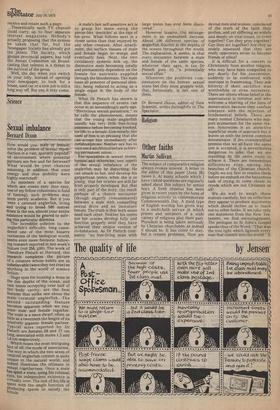,Science
Sexual imbalance
Pernard Dixon
How would you, miiltqfie FettitdKi solve the problem t:Ctextfal'it**100 duction in a vast, sparsely popir140 ed environment where potential partners are few and far between? ' What would be your chances assuming, in addition, that your energy and thus mobility were highly restricted?
As members of a species for Which sex comes easy (too easy, one of my fellow columnists is fond of hinting), such problems may seem purely academic. But if you were a ceratoid anglerfish, living and trying to breed 500 metres down in the sea, almost your entire existence would be geared to solving this particular dilemma. The incredible solution to the anglerfish's difficulty, long considered one of the most bizarre curiosities of the biological world, seems even more fantastic followmg research reported in last week's Nature (vol 256, p38). .The work of Theodore Pietsch at Harvard, this research completes the picture of a creature whose habits are as unbelievable (were they not true) as anything in the world of science fiction.
Huge eyes for locating a mate in the dim depths of the ocean, and vast testes occupying over half of the body cavity, are the first features that strike one about the male ceratoid anglerfish. The second outstanding feature becomes apparent when we examine male and female together. The male is a mere dwarf, often as little as a twentieth the length of its relatively gigantic female partner. Typical sizes reported by Dr Pietsch are females 29 and 17 cm long, associated with males 1.2 and 1.6 cm respectively.
Which raises the most intriguing fact of all: the mode of association The way in which the two sexes of ceratoid anglerfish consort is quite unique in the natural world, and Indeed illustrates the ultimate in sexual togetherness. Once a male has spied a mate, using his colossal eyes, his independent existence is virtually over. The rest of his life is Vent with the single function of producing sperm to satisfy the female. A male's last self-assertive act is to grasp his mate using the pincer-like 'denticles' at the tips of his -jaws. What follows next is a closer union than that enjoyed by any other creature. After attachment, the surface tissues of male and female begin to merge and eventually fuse. Next, the two circulatory systems link up, the diminutive male becoming totally and permanently dependent on the female for nutrients supplied through the bloodstream. The male -loses all pretence of personal identity, being reduced to acting as a single organ in the body of the female.
What Dr Pietsch has shown is that this sequence of events can occur at an astonishingly early age. "Precocious sexual parasitism," as he calls the phenomenon, means that the young maleanglerfish usually has very little free-living existence before becoming hooked, forlife,•to a female. Conversely, her need af,him'is iopressing that she cauhaccept. him immediately after metaincirphdsis Neither sex has to wáitiintiadulthood before achiev-' ingrpermanent union. •
farispeaialists Is sexual mores, hurroanildid ,Otherwise, one aspect of the sexual imbalance of the anglerfish may be disturbing. He can attach to her, and develop his gargantuan testes, when she is so young_ that her ovaries are still far from properly developed. But that is only part of the story, the result perhaps of a chance encounter (though eagerly consummated) between a male with compelling sexual drive and an immature female. The truth is that both sexes need each other. Neither his testes nor her ovaries develop fully and function properly until they have achieved their unique version of co-habitation. As Dr Pietsch comments: "no free-living male with large testes has ever been discovered."
However bizarre, the arrangement is an undoubted success. About 100 different species of anglerfish flourish in the depths of the oceans throughout the world. The explanation, it seems, is that every encounter between a male and female of the same species, whatever their ages, is (as Dr Pietsch puts it) "a potentially sexual affair."
Whatever the problems commentators on the human sexual scene feel they must grapple with, that, fortunately, is not one of them.
Dr Bernard Dixon, editor of New Scientist, writes fortnightly in The Spectator.


































 Previous page
Previous page